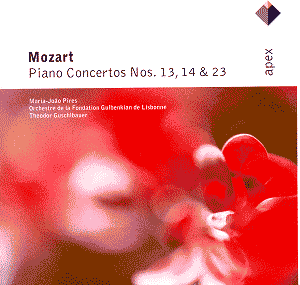During
Mozartís golden final ten years in Vienna, the piano concerto
was his chosen vehicle for presenting himself simultaneously to
his Viennese public as both composer and performer. And no-one
has since surpassed his achievement as a composer of piano concertos.
Between 1782 and 1791 he wrote the concertos Nos. 11 to 27, using
the formal three-movement approach that had already become established
among his contemporaries, and in the concertos he had already
composed while based at Salzburg. If this suggests a formula,
it is only to the extent that all the best formulae in music work
because of their endless possibilities. For as the disc confirms,
each Mozart concerto has its own personality.
The
earliest of the three pieces is the C major Concerto, No. 13,
K415. This has the pomp of trumpets and drums, which immediately
come to the fore in the initial tutti when the principal themes
are paraded. The recorded sound is at its best here, and all credit
to the conductor, Theodor Guschlbauer, for his choice of tempo
which moves the music along while allowing the phrases to breathe.
Maria João Pires proves an imperious soloist, totally in
command. But it is in the slow movement, a tender Andante, that
her talents emerge most tellingly, with a sensitive response to
Mozartís unique expression.
These
strengths are felt elsewhere, although the recorded sound lacks
the subtlety of more recent issues, by the likes of Alfred Brendel
(Philips) or Murray Perahia (Sony). The E flat Concerto, No. 14,
K449, is more tense than either of its fellows on this disc, and
there is a strong sense of teamwork in the performance. This is
a piece that uses a smaller orchestra of strings with oboes, bassoons
and horns, but that does not restrict its dramatic intensity.
The drawback is that the string sound is less subtle in its sound
quality than might be ideal. Whether this is an issue of recording
of ensemble playing is difficult to tell, but the sound is not
always right, sometimes lacking body and focus.
The
A major Concerto, No. 23, K488, is one of the glories of Mozartís
instrumental compositions. The scoring changes the character of
the experience, with flute and clarinets replacing the customary
oboes, while there are no trumpets and drums. The results are
warmly lyrical, though in the finale the rhythmic drive is as
compelling as in any Mozart composition. The slow movement is
extraordinarily beautiful, but while Pires has a clear and unfussy
approach, the results are not quite as effective as, say, Brendel
or Perahia (to repeat the two recommendations already mentioned).
Aside from these slight doubts, the flow is entirely natural,
and there is much to enjoy.
All
too often budget issues compromise when there is no need to do
so. The design and content of booklets seems a frequent target
for misjudgements, and so it proves here. For the badly planned
booklet manages to combine extremely small print with three completely
blank pages, nor is there any biographical information about the
artists.
A
generous compilation of three wonderful Mozart piano concertos,
played by a major pianist, and all at bargain price. Whatever
caveats a reviewer may have, those facts remain a compelling inducement
for the potential purchaser.
Terry
Barfoot
